

Treknology Encyclopedia - L
A B C D E F G H I J K L M N O P Q R S T U V W X Y Z
Landing strut Retractable leg on the Intrepid class for planetary ship landing (VOY).
The Defiant too has a landing gear visible in the MSD , but it has never been shown in action. The real-world reason for that is that the producers were not aware of the MSD.
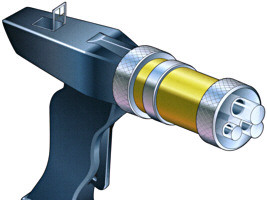
In a real-world laser , the oscillator (a gaseous, fluid or solid matter) is embedded in a resonator, usually consisting of two mirrors. Continuous energy supply leads to an occupation inversion of energy levels within the oscillator, meaning that more electrons are in an excited (higher energy) state than in the normal state. A large amount of narrow-band light is produced, corresponding to electrons falling back to their normal states. A small part of the generated photons generates new excited electrons, while the major part is emitted through one of the mirrors which is semi-transparent. It can be supposed that their principle will not change until the 24th century. There is no good explanation why the crew is using lasers in "The Cage", although Enterprise shows us apparently more advanced phase pistols at a time 100 years earlier.
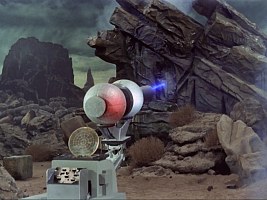
A similar looking laser cannon, however used as a tool here, could be seen in a mine on Earth's Moon in 2155 (ENT: "Demons").
Laser fusion initiator Device used in Cardassian fusion reactors to keep the reaction running (DS9: "Civil Defense", "The Forsaken").
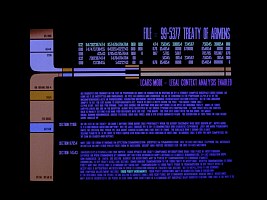
LCARS Acronym for L ibrary C omputer A ccess and R etrieval S ystem, the common user interface of 24th century computer systems, based on verbal and graphically enhanced keyboard/display input and output. The graphical interface adapts to the task which is supposed to be performed, allowing for maximum ease-of-use (generic).
While LCARS-like interfaces are a common feature to date not only for Star Trek websites, it is noteworthy that adaptive graphical user interfaces were a revolutionary idea in 1986 (at least for IBM PC users) when TNG was being projected.
Library computer See computer system , LCARS.
Life prolongation project Experiment conducted on Miri's planet to slow down the human aging process. The experiment failed in a disastrous way when a virus developed to that end killed all adults. Only the children survived, who aged very slowly until they reached puberty and died as well. A cure was found as late as in 2266 (TOS: "Miri").
Life support Designation for a number of ship systems necessary to maintain living conditions for the crew, namely atmospheric system, gravity generators and EPS. The life support systems are distributed throughout the ship and redundant systems are available to provide maximum safety for the crew (generic).
Lifeboat See escape pod .
Life-energy transfer Method of transferring a consciousness from one body to another. In particular, a body-switching technology developed by the now-dead inhabitants of Camus II (TOS: "Turnabout Intruder").
Linear memory crystal Key part of a 24th century Federation computer system (TNG: "Evolution").
Wesley's nanites began to eat the memory crystals on the Enterprise-D.
Linguacode Universal language that may be used in first-contact situation ("Star Trek: The Motion Picture", TNG: "Tin Man", ENT: "In a Mirror, Darkly, Part II").
According to a personnel file visible in the ENT episode, Hoshi Sato invented linguacode in the 2160s. Although not meant to be readable, we may accept that as canon information.
Lithium crystal Part of the power system of a 23rd century Federation starship (TOS: "Where No Man Has Gone Before", "Mudd's Women"). See dilithium crystal .
During the first season the crystals used in the ship's power system were referred to as "lithium crystals". This was changed to "dilithium" because the real element lithium could never have the properties ascribed to it. If we do not choose to ignore the use of the word "lithium" in TOS anyway, it may be at most a nickname for "dilithium", although the "lithium cracking station" on Delta Vega (TOS: "Where No Man Has Gone Before") would not be formally called so.
Locator bomb Anti-personnel weapon of Ferengi manufacture, primarily designed for assassinations. The device contains a sorium-argine explosive and homes in on a specific target individual's pheromones. See also hunter probe .
Log buoy Also called recorder marker, a pod launched from a starship in case of its imminent destruction. The log buoy contains various information that may be used to reconstruct the disaster ("Star Trek: The Wrath of Khan", TOS: "Where No Man Has Gone Before", "The Corbomite Maneuver", ENT: "Babel One").
In ENT: "Babel One" the buoy of the Kumari was called a "data recorder" .

https://www.ex-astris-scientia.org/treknology/treknology-l.htm
Last modified: 04 Oct 2023

© Ex Astris Scientia 1998-2024, Legal Terms
This website is not endorsed, sponsored or affiliated with CBS Studios Inc. or the Star Trek franchise.
Fleet Yards
share this!
December 26, 2022
Giant laser from 'Star Trek' to be tested in fusion breakthrough
by David R Baker, Will Wade, Bloomberg News

The breakthrough came in an impossibly small slice of time, less than it takes a beam of light to move an inch. In that tiny moment, nuclear fusion as an energy source went from far-away dream to reality. The world is now grappling with the implications of the historic milestone. For Arthur Pak and the countless other scientists who've spent decades getting to this point, the work is just beginning.
Pak and his colleagues at Lawrence Livermore National Laboratory are now faced with a daunting task: Do it again, but better—and bigger.
That means perfecting the use of the world's largest laser, housed in the lab's National Ignition Facility that science-fiction fans will recognize from the film "Star Trek: Into Darkness," when it was used as a set for the warp core of the starship Enterprise. Just after 1 a.m. on Dec. 5, the laser shot 192 beams in three carefully modulated pulses at a cylinder containing a tiny diamond capsule filled with hydrogen, in an attempt to spark the first fusion reaction that produced more energy than it took to create. It succeeded, starting the path toward what scientists hope will someday be a new, carbon-free power source that will allow humans to harness the same source of energy that lights the stars.
Pak, who joined the Lawrence Livermore lab outside San Francisco in 2010, woke at 3 a.m. that day, unable to resist checking the initial results from his San Jose home. He'd tried staying awake for the shot itself, finally giving up as the experiment's painstaking preparations dragged late into the night. "If you stayed up for every shot, every time for 10 years, you'd go insane," he said.
For the last several months, it was clear his team was getting close, and in the pre-dawn dark, he checked for a key number that could show whether they'd succeeded—a count of neutrons the blast produced.
"When I saw that number, I was blown away," he said.
"You can work your whole career and never see this moment. You're doing it because you believe in the destination, and you like the challenge," said Pak, leader for diagnostics on the experiment. "When humans come together and work collectively, we can do amazing things."
The team at Lawrence Livermore—a government-funded research lab—will likely run its next test in February, with several more experiments to come in the months after. The goal will be to keep increasing the amount of energy that's produced in the reaction. The means more tinkering: Use more laser energy. Fine-tune the laser blast. Generate more X-rays within the target—a key step of the process—using the same amount of energy. Maybe, eventually, upgrade the facility itself, a decision that would require buy-in from the Energy Department and a huge amount of funding.
All of that will take years, if not decades, starting with the Lawrence Livermore lab's bite-sized experiments that last just nanoseconds.
"We need to figure out: Can we make it simpler? Can we make this process easier and more repeatable? Can we begin to do it more than one time a day?" said Kim Budil, director of the Lawrence Livermore lab. "Each of these is an incredible scientific and engineering challenge for us."
Most experts forecast that the world is still at least 20 to 30 years away from fusion technology becoming viable on a scale that's large and affordable enough to produce commercial power. That timeline places fusion beyond the scope of significantly being used to reach the world's net-zero emissions goals by 2050. In that sense, fusion could be the carbon-free energy source of the future, but not of the current global energy transition that's faced continuous hurdles.
Fusion has captured the scientific imagination for decades. It's already used to give modern nuclear weapons their devastating power, but the dream is taming it for civilian energy demand. If it can be brought to scale, it would lead to power plants that supply abundant electricity day and night without emitting greenhouse gases. And unlike the nuclear power of today, sparked through a process called fission, it wouldn't create long-lived radioactive waste. Entire generations of scientists have pursued it. President Joe Biden's chief science advisor, Arati Prabhakar, spent a summer working on the lab's laser-fusion program as a 19-year-old college student in bell bottoms—in 1978.
"This is such a tremendous example of what perseverance can achieve," she said at a press conference last week. "This is how you do really big, hard things."
Merging atoms
The successful laser shot produced fusion reactions generating 3.15 megajoules of power, topping the 2.05 megajoules imparted by the laser. It was a major threshold, the first time more energy came out than went in from the laser. But the equation needs to tilt much more in the direction of how much comes out to become commercially viable.
While today's nuclear power plants employ fission, splitting atoms apart, fusion merges atoms together. Fusion researchers have followed two primary tracks. Lawrence Livermore, using a process called inertial confinement, blasts targets with laser beams, imploding a small amount of hydrogen until it fuses into helium. A commercial plant using this approach would need to repeat the process over and over again, extremely rapidly, to generate enough energy to power the electric grid.
Numerous companies are developing inertial confinement systems, though there are significant differences. Some are looking at different materials for the target, while others use particle accelerators instead of lasers, triggering the fusion reaction by slamming atoms together.
The main competing idea is called magnetic confinement, with systems that create a cloud of plasma, superheated to hundreds of millions of degrees, which can trigger a fusion reaction. Powerful magnets control the plasma and sustain the reaction. This approach has not yet achieved a net-energy gain, and the approach faces challenges including developing better magnets and creating materials that can withstand superhot temperatures and be used for the container to contain the plasma.
About $5 billion in funding has gone into fusion companies to date, with the vast majority aimed at magnetic confinement technologies, according to the Fusion Industry Association trade group.
Inertial confinement may be better suited to proving that fusion can work, said Adam Stein, director of nuclear energy innovation at The Breakthrough Institute, an Oakland, California-based research group. But in the longer run when it comes to commercialization, "plasma magnetic confinement is more likely to succeed," he said.
'Be an optimist'
Years were spent refining each part of the process at the Lawrence Livermore lab.
A lot of the success came down to precision. The fuel capsules all contain minute imperfections that can make a significant difference in how the reaction proceeds. So can the frozen hydrogen inside, a mix of the isotopes deuterium and tritium. The team would often produce the hydrogen ice, melt it back down and try again several times before a shot, hoping to get the best possible target and increase the chances of success.
Everyone working on fusion "has to be an optimist," said Denise Hinkel, a physicist who focuses on improving the predictive ability of the program's computer simulations and who has worked at Lawerence Livermore for 30 years. "Otherwise, you wouldn't stay in the field."
By this summer, the giant laser will be able to deliver about 8% more energy than it did during this month's shot, according to Jean-Michel Di Nicola, chief engineer for the National Ignition Facility's laser. Michael Stadermann, the target fabrication program manager, said that the lab is also developing a computer program that can examine the fuel-capsule shells for flaws much faster than humans can. They're also working with capsule maker on improving the fabrication process.
It's possible that the Lawrence Livermore breakthrough will remain just a moment of scientific history, and not mark the beginning of a new fusion industry powering the globe. Bridging the gap from experiment to commercialization could take decades, if it happens at all. And magnetic confinement could eventually be the fusion method that wins out, providing the world abundant clean energy. Pak, a soft-spoken man with a swoop of brown hair and a quick wit, said that outcome wouldn't disappoint him.
"They can learn from us—we can learn from them," Pak, 40, said. "When I'm an old man, I'm going to be really satisfied with my contributions."
2022 Bloomberg L.P. Visit bloomberg.com. Distributed by Tribune Content Agency, LLC.
Explore further
Feedback to editors

Researchers discover new lantibiotic produced by staphylococci
6 hours ago

Study says California's 2023 snowy rescue from megadrought was a freak event. Don't get used to it
7 hours ago

'Sour Patch' adults: 1 in 8 grown-ups love extreme tartness, study shows

Long snouts protect foxes when they dive headfirst into snow, study finds

Laser imaging could offer early detection for at-risk artwork
8 hours ago

Tibetan plateau had broader social dimensions than previously thought, suggests study

Machine learning classifies 191 of the world's most damaging viruses

Theoretical biologists test two modes of social reasoning and find surprising truths in simplicity

It's all in the smile: New research finds politicians can influence voters with facial expressions
9 hours ago

New system boosts efficiency of quantum error correction
Relevant physicsforums posts, where are these neutrino masses coming from, axial version of the phi meson.
14 hours ago
Pandora's Box: Carbon-14 vicious cycle from transmutation
Apr 27, 2024
I wonder about a particle's energy when mass is obtained or lost
Apr 25, 2024
Can proton/neutron decay be avoided in some conditions?
Apr 23, 2024
Do Magnets Emit Harmful Radiation?
Apr 18, 2024
More from High Energy, Nuclear, Particle Physics
Related Stories

'Breakthrough' as fusion energy generates excess energy for first time
Dec 13, 2022

EXPLAINER: Why fusion could be a clean-energy breakthrough

Nuclear fusion: harnessing the power of the stars

US scientists set to announce fusion energy breakthrough

Fusion breakthrough is a milestone for climate, clean energy

The US achieved a major nuclear fusion breakthrough. Here's why fusion power is still decades away
Dec 14, 2022
Recommended for you

Physicists overcome two key operating hurdles in fusion reactions
12 hours ago


Record electron temperatures for a small-scale, sheared-flow-stabilized Z-pinch fusion device achieved

Creating an island paradise in a fusion reactor
Apr 16, 2024

A return to roots: Lab builds its first stellarator in 50 years and opens the door for research into new plasma physics
Apr 2, 2024

Plasma fusion: Adding just enough fuel to the fire
Mar 28, 2024

New research on tungsten unlocks potential for improving fusion materials
Mar 13, 2024
Let us know if there is a problem with our content
Use this form if you have come across a typo, inaccuracy or would like to send an edit request for the content on this page. For general inquiries, please use our contact form . For general feedback, use the public comments section below (please adhere to guidelines ).
Please select the most appropriate category to facilitate processing of your request
Thank you for taking time to provide your feedback to the editors.
Your feedback is important to us. However, we do not guarantee individual replies due to the high volume of messages.
E-mail the story
Your email address is used only to let the recipient know who sent the email. Neither your address nor the recipient's address will be used for any other purpose. The information you enter will appear in your e-mail message and is not retained by Phys.org in any form.
Newsletter sign up
Get weekly and/or daily updates delivered to your inbox. You can unsubscribe at any time and we'll never share your details to third parties.
More information Privacy policy
Donate and enjoy an ad-free experience
We keep our content available to everyone. Consider supporting Science X's mission by getting a premium account.
E-mail newsletter
New Item: Available Now!

Star Trek TNG Laser Cannon Kits

ST:TNG Laser sight cannons are finally here! Tired of missing those targets? Are you squatting to get your eyes down to glass level so you can aim your cannons? One shot is all you get! If you miss then you have to reload your cannon!
Now the creator of Mick's Pinball has developed something that William's only wished they had thought of, let alone others. Mick's patent pending laser cannons are now available for your ST:TNG game! Being in the business of manufacturing, Mick has painstakingly recreated, improved upon, and redesigned the ST:TNG turrets as replacements for your game.
Few will remember that the original prototypes had a red dome on top that was removed from William's to keep the cost down. Mick has brought the red dome back along with enhanced turret details and stronger plastic, what an improvement!
In addition to above improvements, the turret has now been fitted with a laser beam that helps you aim that ball and consistently hit those targets! Man, you have got to be kidding, a new and improved cannon turret for the ST:TNG. Finally someone has stepped up and is providing the best for your games. Mick's pinball is the only place you will find this, and you can order yours today.
Those of you that have received your items from me, please send me feedback so any improvements on products can be made in the future. I'm eager to hear what the pinball community has to say about these revolutionary topper kits. Who knows, maybe your feedback will end up on the list of so many happy customers on the Testimonials page.

56 Years Later, Star Trek Canon Finally Addresses Its Trickiest Moral Question
Genetic engineering doesn’t make you a villain.
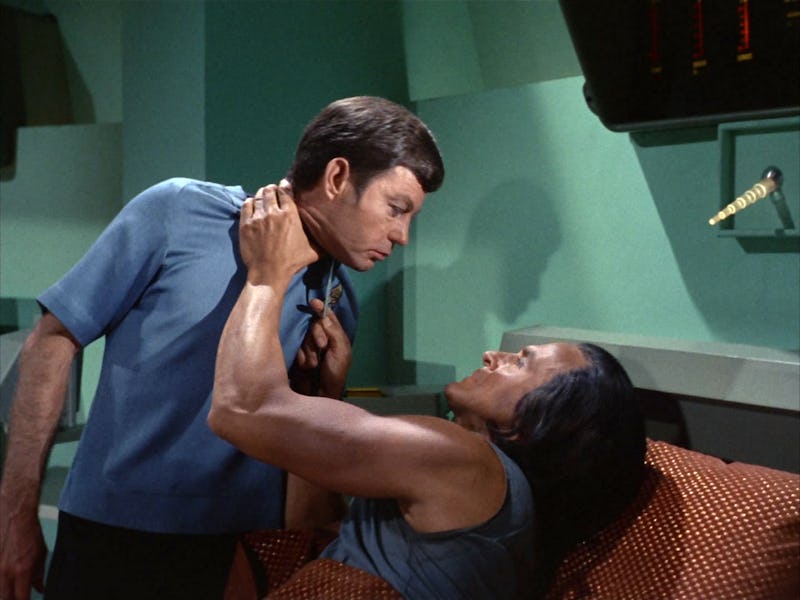
People will never get over Khan. From his introduction in the 1967 episode “Space Seed,” to the famous Wrath of Khan , to the Benedict Cumberbatch version in 2013, and most recently, his distant descendent, La’an Noonien-Singh in Strange New Worlds , Star Trek’s most infamous genetically enhanced supervillain casts a long shadow. But, 56 years after Khan’s debut, the Trek canon is flipping the script on the nature of Khan’s villainy. For a long time, Star Trek has (mostly) posited that people like Khan were evil because they were genetically enhanced. But what Strange New Worlds presupposes is — maybe not?
In the Season 2 Strange New Worlds episode “Ad Astra per Aspera,” Una Chin-Riley (Rebecca Romijn) faces legal charges. In a bit of retcon, Season 1 of SNW established that Una was secretly an Illyrian, an alien culture that practices genetic modification as a way of life. In “Ghost of Illyria,” we learned that Una had hidden her genetic modifications to blend in at Starfleet, and in “A Quality of Mercy,” Starfleet arrested her for violating its anti-genetic modification laws. Why can’t you be genetically modified in the open-minded, egalitarian Star Trek future? Well, it all comes down to Khan.
Khan’s genetics backstory explained

Khan in “Space Seed.”
When “Space Seed” aired during Star Trek’s first season in 1967, the show was still making up its future history. Even the year The Original Series took place hadn’t been established. Khan says he’s been sleeping for “200 years,” but because this episode of TOS was later established to have taken place in 2267, it’s more like 271 years. But the point here is that Star Trek pre-history begins in the 1990s.
“Space Seed” established that Khan was a tyrant who ruled part of Earth in the 1990s and was exiled in suspended animation “sleeper ship” in 1996. This conflict was called the Eugenics Wars, which in “Space Seed” Spock calls “the era of your last so-called World War.”
Trek canon has been stuck with this tricky chronology ever since. Once the Eugenics Wars failed to occur in the real 1990s, various Treks lampshaded or outright contradicted their date and Khan’s rise to power. Greg Cox's trilogy of novels, The Eugenics Wars , began in 2001 and combined fuzzy Star Trek history with real ‘90s history by making Khan’s rise to dominance a secret war fought under false flags and without the general public's knowledge. In the 1996 Voyager two-parter “Future’s End,” the crew traveled back to 1996, where they shrugged their shoulders at the fact there was no evidence of an ongoing World War III. More recently, in Strange New Worlds and Picard Season 2, it’s been suggested the Eugenics Wars led to World War III, and that led to a third of the Earth’s population dying. Then you’ve got a Mad Max -style Earth until 2063 when the Vulcans make first contact.
Trek canon has some wiggle room. In “Space Seed,” Spock said, “Records of that period are fragmentary.” So if you think the new Trek canon is retconning Khan’s origins a bit, brace yourself for even more changes in the future. Was Khan really around in the 1990s? Or was he on Earth later?
How Strange New Worlds goes deeper than TOS

Yetide Badaki as Neera.
If you put aside the trickiness of early Star Trek chronology, what’s interesting about “Ad Astra per Aspera” is that it inverts previous assumptions about the Federation, and turns the existence of Khan into a scapegoat for massive bigots at Starfleet. Season 1 of Strange New Worlds explored this a bit with La’an’s backstory and Number One getting arrested for being an Illyrian, but now it’s going much deeper. Here, Una’s Illyrian lawyer, Neera (Yetide Badaki), has no love for the Federation or Starfleet, because she’s experienced prejudice for being genetically altered her entire life. Neera makes it clear the Federation has used Khan’s atrocities to justify widespread discrimination.
This stigma runs so deep that, during a private conversation with La’an, Neera points out that just because you’re descended from a supervillain —La’an is distantly related to Khan — that doesn’t mean “there’s a monster” inside you. La’an is human, but Neera and Una are not, and thus Strange New Worlds makes a leap that Trek has never quite made before.

Una and Neera in Strange New Worlds .
In the Deep Space Nine episode “Doctor Bashir, I Presume?” it’s revealed that Julian Bashir was genetically enhanced by his parents when he was very young. A similar conflict arises, and Khan is alluded to, but there’s a crucial difference. In TOS and Deep Space Nine , the idea that genetic alterations could be a cultural norm is never explored. It’s always viewed as a moment where science goes too far. Julian is nice in spite of his genetic modifications, but his parents still transgressed human cultural norms.
Strange New Worlds builds on all of this and makes the subject much more interesting because while Una has violated Federation law, we see an entire culture of Ilyrians living and thriving in the Volterra Nebula. Some may pass for human, but judging people by their appearance is a practice Star Trek has often strived to dismantle. When Pike visits the Illyrian world to recruit Neera, the environment is hostile to his biology. The Illryians aren’t monsters. Pike is the gas-mask-clad outsider, and a representative of the Federation the Illyrians view as narrow-minded bigots.
The resolution of “Ad Astra per Aspera” creates a loophole where Una can stay in Starfleet while making it clear Starfleet isn’t changing its mind. This preserves canon, but the impact is deeper than dot-connecting. With this episode, Strange New Worlds has pointed out that the so-called utopia of the Federation still has its biases and bigots, and that even in the 23rd Century, humans can do better.
Star Trek: Strange New Worlds streams on Paramount+.

This article was originally published on June 24, 2023
- Science Fiction
Memory Beta, non-canon Star Trek Wiki
A friendly reminder regarding spoilers ! At present the expanded Trek universe is in a period of major upheaval with the continuations of Discovery and Prodigy , the advent of new eras in gaming with the Star Trek Adventures RPG , Star Trek: Infinite and Star Trek Online , as well as other post-57th Anniversary publications such as the ongoing IDW Star Trek comic and spin-off Star Trek: Defiant . Therefore, please be courteous to other users who may not be aware of current developments by using the {{ spoiler }}, {{ spoilers }} OR {{ majorspoiler }} tags when adding new information from sources less than six months old (even if it is minor info). Also, please do not include details in the summary bar when editing pages and do not anticipate making additions relating to sources not yet in release. THANK YOU
- Memory Beta articles sourced from RPGs
- Memory Beta articles sourced from games
- Laser weapons
- Directed energy weapons
- Hand-held weapons
Laser rifle
- View history
The laser rifle was a hand-held energy weapon, the predecessor of the phaser rifle . It was used on Earth as early as the mid 21st century . ( TOS novel : Strangers from the Sky )
Laser rifles continued to be in use by Starfleet into the 23rd century , until at least 2266 . Captain James T. Kirk used a laser rifle to attack a city builder on the planet Zarta . ( TOS comic : " Invasion of the City Builders ")
- 1.1 Connections
- 1.2 References
- 1.3 External links
Appendices [ ]
Connections [ ], references [ ].
- FASA RPG module : Star Fleet Intelligence Manual: Game Operations
- FASA RPG module : Trader Captains and Merchant Princes, 1st edition
External links [ ]
- Laser rifle article at Memory Alpha , the wiki for canon Star Trek .
- 1 ISS Enterprise (NCC-1701)
- 3 Odyssey class

Phase cannon
- View history
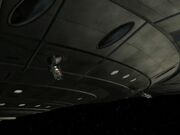
Phase cannons being deployed
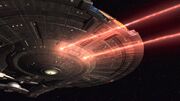
Phase cannons firing
A phase cannon was a phase-modulated directed energy cannon weapon , a type of particle weapon which served as a successor to plasma cannons and as a precursor to the phaser of the 23rd and 24th centuries . The prototypes of ship-mounted phase cannons were first introduced by Starfleet in the mid- 22nd century , designed as the primary defense of NX-class starships and serving as a supplement for the lacking spatial torpedoes of the time. The first NX-class vessel to test and actively use phase cannons in battle was Enterprise NX-01 .
- 2.1 Initial test and early use
- 2.2 New protocols
- 2.3 Later uses and applications
- 2.4 The Expanse
- 3 Alternate timelines
- 4 Background information
Specifications [ ]

Phase cannon schematics
Designed as a starship-based version of the hand-held phase-pistol , the phase cannon was rated for a maximum power output of 500 gigajoules . The cannons of NX-class starships were mounted on retractable turrets which extended from the ship's hull when deployed and rotated as they were being targeted. Like phase-pistols, phase cannons emitted a concentrated beam of energy that could be set at different yields. ( ENT : " Silent Enemy ")
Aboard an NX-class vessel, the assembly was located on F Deck and could be accessed through a hatch within the armory . Instead of drawing power from the EPS grid , as they were designed, armory officer Lieutenant Malcolm Reed tied the turret relays directly into the impulse engines to increase their yield by eighty percent. Inverters were installed to cut in at the first sign of an overload. ( ENT : " Silent Enemy ", " Horizon ") These phase cannon assemblies were equipped with multiphasic emitters and could produce a beam with the maximum yield of 500 gigajoules. ( ENT : " Silent Enemy ") Later it was indicated that they could only emit 80 gigajoules.( ENT : " Cogenitor ") The cannons could also be overloaded by many times their normal maximum output, though this could cause significant feedback damage.
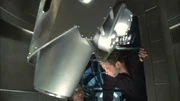
Reed and Tucker examine the phase cannon assembly
When initially installed on the first NX-class vessel in 2151 , the phase cannons were located on the ventral side of the ship. Two were placed at the bow of the vessel, while one was placed at the aft on the ship's starboard side. ( ENT : " Silent Enemy ", " Fallen Hero ") By 2152 the first vessel of this class, the Enterprise NX-01, was outfitted to hold at least four cannons on the dorsal saucer section ; two at the bow and two closer to the stern , with one on each of the catamaran-like sections. ( ENT : " Shockwave, Part II ", " Singularity ") An additional ventral aft cannon was added on the port section of the NX-class some time after the first cannons' installation. ( ENT : " Future Tense ", " Similitude ") Two more cannons were installed on the ventral part of the saucer section, only closer to the bow than the first cannons. ( ENT : " Bounty ", " Storm Front, Part II ") Yet two more pairs of cannons were added to the dorsal and ventral side of the nacelle pylons , near the impulse rockets , some time prior to 2154 . ( ENT : " E² ", " The Aenar ")
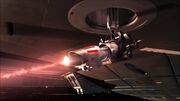
Enterprise fires its aft cannon
Phase cannons were generally more powerful than spatial torpedoes and were therefore more effective in a firefight. Initially, Enterprise 's phase cannons could not be fired while the vessel was at warp , as doing so would cause the weapon's particle discharge to destabilize the ship's warp field . This, in turn, would result in serious damage to both of the ship's warp nacelles , and could possibly even destroy them. ( ENT : " Fallen Hero ") By 2152, Enterprise armory officer Malcolm Reed had corrected this problem as the ship was able to fire its phase cannons at warp while it was pursued by a Suliban fleet. ( ENT : " Shockwave, Part II ") Phase cannons took some time to charge when manually activated. This issue was resolved with the implementation of Reed's tactical alert , which brought the weapons automatically online after the alert was given. ( ENT : " Singularity ")
Despite their power, phase cannons were sometimes unable to penetrate the defenses of other alien vessels. Not only did they prove relatively powerless against the shields of the first vessel they were used against, but it would have also taken a sustained beam to punch through the hull of a D5-class battle cruiser . That was assuming, of course, that the battle cruiser remained still long enough, which was unlikely. ( ENT : " Judgment ", " Silent Enemy ") Likewise, the cannons could be easily taken out with a single photon torpedo shot from a Klingon Bird-of-Prey . ( ENT : " The Expanse ") Because of this, Klingons regarded the cannons, which they identified as "low-yield particle cannons", to be of little threat. ( ENT : " Judgment ")
History [ ]
Initial test and early use [ ].
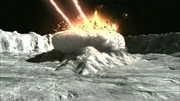
The first phase cannon test…
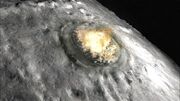
…and the explosive results
Enterprise was originally designed to carry three phase cannons. However, due to Enterprise 's premature launch in 2151, Jupiter Station did not get the chance to install the cannons, though Enterprise was given one of the prototypes. On August 30 th , 2151, Malcolm Reed and Trip Tucker were given the job of installing the prototype, as well as building two more from scratch. Leading the Engineering team, they were able to accomplish the installation – two forward cannons, one aft – in 48 hours, a job that would have taken the armory team at Jupiter Station at least a week.
The initial test of Enterprise 's phase cannons was conducted on September 1 st , on an lifeless moon . The first shot was only to have "shaved" a few meters off the top of a mountain peak equivalent to Mount McKinley , but the blast was so powerful that it formed a new crater on the surface. The resulting overload of the phase modulators caused a plasma recoil that blew out relays across decks C and D. Following this, it was determined that the blast yield of the shot was ten times what was expected. It was then that the crew realized that the cannons had been manipulated by a mysterious alien race.
When the alien beings attacked Enterprise , the cannons proved ineffective against the alien vessel's shielding. Reed and Tucker then caused another overload, this time intentionally, while repolarizing the gravity plating to absorb the plasma recoil and shunt the resultant energy to strengthen structural integrity . The resulting overload again increased the cannon's blast yield, which disabled the aliens' shields and allowed Enterprise to gain the upper hand. ( ENT : " Silent Enemy ")
In February of the following year, Enterprise used its aft phase cannon to disable the shields and engines of a Mazarite ship, although Enterprise had to drop to impulse to do so. Travis Mayweather recounted this incident to his brother, Paul , in January of 2153 . ( ENT : " Fallen Hero ", " Horizon ")
Shortly thereafter, the forward cannons were used to disable a cloaked Suliban vessel hidden within a binary star system . While an assault team was on the ship acquiring information, the cannons were again used on the Suliban ship to collapse a corridor containing several Suliban, clearing the way for the assault team to escape. ( ENT : " Shockwave ")
Later, while escaping the Suliban helix , Enterprise used its aft cannon on the pursuing Suliban cell ships while at warp speed. The cannons destroyed at least one of the ships. ( ENT : " Shockwave, Part II ")
New protocols [ ]
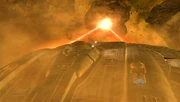
Phase cannons fire on an asteroid
In August of 2152, Reed proposed new tactical protocols that would increase the efficiency of Enterprise 's weapons, including the phase cannons. While under the influence of radiation emitted from a nearby singularity , Reed implemented the new protocols without Captain Archer 's permission.
Later, with the rest of the crew having succumbed to the radiation, Archer and T'Pol attempted to navigate Enterprise away from the singularity as quickly as possible by piloting the starship through a field of debris. When the need arose to use weapons against a large meteoroid that was in the ship's path, T'Pol worried that the phase cannons could not be charged in time. However, when a smaller piece of the meteoroid collided with the ship, Reed's tactical protocols initiated and the phase cannons were automatically brought online. T'Pol then used the cannons to destroy the remaining meteoroids, allowing Enterprise to safely escape the singularity. Following this incident, Reed's new security protocols were made standard procedure. ( ENT : " Singularity ", " Cease Fire ")
Later uses and applications [ ]
The following month, the cannons were used in an attempt to disable the engines of a Retellian freighter which had captured Commander Tucker. Although the cannons appeared to disable the freighter's port warp nacelle, it was merely a ruse by the freighter's pilot, Goff , to disable Enterprise 's own warp engines. ( ENT : " Precious Cargo ") Later, Commander Tucker threatened to use Enterprise 's cannons on Vulcan and Andorian vessels if they attempted to enter orbit of Weytahn . ( ENT : " Cease Fire ") Not long afterwards, a vessel crewed by noncorporeal beings were able to take Enterprise 's cannons off-line and capture the ship, although Enterprise ultimately escaped. ( ENT : " The Crossing ")
The ship's aft phase cannons were later used in defense against a group of Suliban cell ships which were pursuing Enterprise in an attempt to capture the Earth vessel in the ship's launch bay . The cannons destroyed at least one cell ship; several Tholian ships took care of the rest. ( ENT : " Future Tense ")
The cannons were later used in battle against a Klingon Bird-of-Prey commanded by Duras , although they did negligible damage. ( ENT : " Judgment ") In March of 2153 , the cannons were used to disable the weapons of Arctic One , which had been taken over by the Borg . Later, after several spatial torpedoes were used to weaken Arctic One , a single, final shot from a phase cannon destroyed the transport . ( ENT : " Regeneration ") Later that same month, the cannons were used to destroy a decoy device which was generating a false Tellarite warp signature and preventing Enterprise from locating the Tellarite ship which had captured Captain Archer. ( ENT : " Bounty ")
By 2153, phase cannons were installed on several other classes of Starfleet vessels as well, including Intrepid -type and another type of starships. ( ENT : " The Expanse ")
The Expanse [ ]
Phase cannons proved to be vital part of Enterprise 's weapons complement during the starship's search for the Xindi weapon in the Delphic Expanse . ( ENT Season 3 )
During the Xindi incident , a phase cannon emitter aboard Shuttlepod 1 was used to destroy the locking mechanism of a Delphic Expanse sphere so the vehicle could gain entrance. Later, Enterprise fired its cannons at the sphere to lure an Osaarian pirate ship into close vicinity of Enterprise so Hoshi Sato could download information on the Xindi from the pirate ship's computer banks. Although the first attempt using a single, minimum yield blast from one cannon did not succeed, a second blast using both cannons destroyed the sphere's portal and got the Osaarians to attack Enterprise , allowing Sato to successfully download the information they needed. ( ENT : " Anomaly (ENT) ") The cannons were later used against two Xindi-Reptilian vessels who were attempting to retrieve their spy, Rajiin , from Enterprise . ( ENT : " Rajiin ")
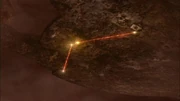
Phase cannons used on particles covering the ship's hull
Several months later, when Enterprise entered a polaric field and its hull was bombarded with nucleonic particles , the aft cannons were redirected towards the back end of the hull and used to blast away the particulates which had accumulated on the ship's launch bay doors. This allowed for the launch of the ship's shuttlepods , which were then used to tow Enterprise a small distance, giving the larger vessel a strong enough momentum to clear the polaric field. ( ENT : " Similitude ")
The cannons were later used to quell attacking Triannon ships who were defending themselves against Enterprise while the starship was under the control of D'Jamat and his religious sect. After Archer reclaimed command of Enterprise , he had the cannons powered down to prove the starship was no longer a threat. ( ENT : " Chosen Realm ")
As Enterprise pressed forward into the Delphic Expanse in search of the Xindi weapon , the ship came into contact with a number of debilitating spatial anomalies . One severe encounter in December of 2153 disabled all of the ship's weapons, including the phase cannons. Fortunately, the Andorian warship Kumari , under the command of Shran , was nearby to lend assistance. Shran assigned his tactical officer , Lieutenant Talas , to assist Lieutenant Reed in repairing the weapons. With Talas's help, the phase cannons were not only operational within a short period of time, but were also working at 94% efficiency. This was an improvement, as Reed was never able to exceed 93% efficiency from the cannons. Soon after the phase cannons were brought back on-line, they were used to disable two Xindi-Reptilian vessels, allowing the Kumari to seize the prototype of the Xindi weapon. ( ENT : " Proving Ground ")
Shortly afterwards, the cannons were again used to disable another Xindi vessel, this time belonging to the Xindi-Primate Degra . He and his crew were then captured in order to gain information on the whereabouts of the Xindi weapon. ( ENT : " Stratagem ") The following month, the cannons were again used in an attempt to disable the engines of a Xindi-Insectoid vessel, but they proved ineffective. ( ENT : " Hatchery ")
Enterprise suffered severe damage following a battle with Xindi-Reptilian and Xindi-Insectoid vessels near the red giant , Azati Prime , resulting in the loss of the ship's weapons, including phase cannons. Following their repair, the cannons were used against an Illyrian starship while an Enterprise boarding party stole the alien ship's primary warp coil . During the assault, T'Pol had Reed adjust the cannons to a narrow confinement beam and disable the Illyrian ship's power junction, allowing the boarding party to remove the warp coil and transport it and the party back to Enterprise . ( ENT : " Azati Prime ", " Damage ") Nonetheless, at least two of the front cannons were not operational until two days after the Xindi attack. ( ENT : " The Forgotten ")
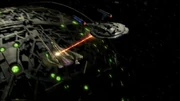
Phase cannons strike the Xindi weapon
Later, the cannons were deployed as defense against a group Kovaalan ships within a nebula . Disturbance from the nebula interfered with the cannons' targeting scanners, making it necessary for its target to be within close range. ( ENT : " E² ") Soon after, Enterprise participated in a major battle in which the starship's phase cannons were used against Xindi-Insectoid and Reptilian vessels as they escorted the weapon away from the Xindi Council planet . At least one Insectoid ship was damaged after being struck by a phase cannon beam. ( ENT : " The Council ") A short time later, Enterprise 's original forward phase cannons (coupled with photonic torpedoes ) were used in an attempt to destroy the Xindi weapon before it could be launched against Earth. Again, at least one Xindi-Insectoid ship was destroyed by the phase cannons during this battle. Also during the battle, phase cannons were used in defense against the lead Reptilian ship while a team of MACOs infiltrated the ship to rescue Ensign Sato. ( ENT : " Countdown ")
By the time Enterprise had completed its mission in the Expanse and returned to Earth in 2154 , Starfleet, upon the recommendation of Captain Archer, had developed pulsed phase cannons . These advanced phase cannons were installed aboard the Columbia NX-02 . ( ENT : " Home ")
During the Augment Crisis of May 2154, Captain Archer was trapped within the central core of Cold Station 12 , where he was in danger of being infected with the thousands of deadly pathogens stored there. With interference from the core preventing his transport , Enterprise 's phase cannons were used to open the core's outer hatch, decompressing the core and blowing Archer into space. After being exposed to the vacuum of space for only an instant, Archer was transported back to the safety of Enterprise .
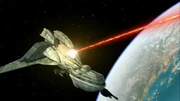
Klingon Bird-of-Prey struck by a phase cannon
Later, Enterprise was able to stop the Augments from using pathogens stolen from the station to infect a Klingon colony . In retaliation, the Augments – aboard a stolen Klingon Bird-of-Prey – attacked Enterprise , disabling all weapons save for the ship's aft cannon, which was then used to destroy the Klingon ship's main plasma junction and disable the vessel. ( ENT : " The Augments ")
Enterprise later employed the cannons against a fleet of Vulcan warships which attacked the Starfleet vessel to drive it away from their planet , as per orders from Administrator V'Las . However, Enterprise proved to be no match for the Vulcans and was forced to retreat. ( ENT : " Awakening ") A short time later, the cannons were again used against the Vulcans to defend Andorian ships during a skirmish near Regulus , but the weapons were unable to penetrate the Vulcan ships' shields. ( ENT : " Kir'Shara ")
In November of that year, Enterprise used the cannons in an attempt to disable what appeared to be an Andorian warship which had attacked them without provocation. The cannons proved ineffective against the Andorian ship's shields, and even after Commander Shran supplied Enterprise with the coordinates for the attacking vessel's shield generator , the shields remained intact. The attacking vessel was ultimately forced to withdraw due to a fluctuation in its power grid, and it was later discovered that it was actually a drone ship controlled by the Romulans and capable of disguising itself as other vessels using holographic technology . ( ENT : " Babel One ")
The drone ship was able to simulate phase cannon fire using tri-phasic emitters , as evidenced by its attack on a Rigelian scoutship while disguising itself as Enterprise . Later, the real Enterprise intercepted the drone ship a second time, using phase cannons to disable its holographic emitters. Without its camouflage, however, the drone ship proved far too maneuverable for Enterprise to lock onto it in order to disable the drone's weapons. This forced the Starfleet vessel to shut down its own weapons and divert power to its hull plating . ( ENT : " United ") Enterprise later employed phase cannons when facing off against two drone ships, but it was only through the assistance of Jhamel and the sacrifice of Gareb , two Aenar , that the drone ships were destroyed. ( ENT : " The Aenar ")
Later that month, Enterprise fired phase cannons at a Klingon Bird-of-Prey which had attacked the Starfleet vessel near the wreckage of a Rigelian freighter , but they were unable to prevent a Klingon boarding party from transporting aboard Enterprise and sabotaging its warp matrix . ( ENT : " Affliction ")
Both Enterprise and Columbia used their phase cannons against three Klingon battle cruisers that were attempting to eradicate Qu'Vat Colony . Although Columbia managed to disable one of the Klingon ships, the cannons for the most part were ineffective against the battle cruiser's shields. Retaliation from the Klingons resulted in the loss of Columbia 's weapons and Enterprise 's aft phase cannons. Ultimately, however, a peaceful resolution was found and the colony was spared. ( ENT : " Divergence ")
In December 2154, Captain Archer, while under the influence of pheromones secreted by the three Orion slave girls aboard Enterprise , ordered Reed to fire the phase cannons at an attacking science vessel despite the fact that it was of no threat to Enterprise due to its low-yield weaponry. Because a single phase cannon hit would destroy the vessel, Reed refused to follow Archer's orders. Archer began to aim the cannons himself, but, as T'Pol had predicted, the science vessel ceased its attack and moved off. ( ENT : " Bound ")
In 2256 , the USS Shenzhou was known to have been armed with phase cannons. First officer Michael Burnham suggested they be targeted at an unknown object of possible Klingon origin as a way of luring the Klingons out from hiding. ( DIS : " The Vulcan Hello ")
Alternate timelines [ ]
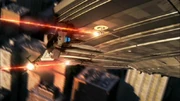
The two ventral bow cannons hit a Stuka
In 1944 of an alternate timeline in which Earth's history had been altered as a result of the Temporal Cold War , Enterprise 's original forward phase cannons were used in an attempt to prevent Shuttlepod 1 , which had been hijacked by Silik , from reaching Earth. The cannons managed to damage the pod, but it was able to land on Earth nonetheless. ( ENT : " Storm Front ") Soon after, the cannons were used to subdue a squadron of Stukas , allowing Enterprise to destroy the facility housing the Na'kuhl and their temporal conduit and returning the timeline to normal. ( ENT : " Storm Front, Part II ")
In 2154, an Enterprise from an alternate timeline carried the same complement of weapons as Enterprise of 2154, despite the former vessel having been in existence for 120 years. Thus, the alternate Enterprise continued to use phase cannons, although they now fired a blue beam of energy rather than an orange beam. ( ENT : " E² ")
In an alternate timeline in which Earth was destroyed by the Xindi weapon, phase cannons were still a Starfleet vessel's primary line of defense in 2165 . In that year, Enterprise 's cannons were used to knock out the engines of a Yridian ship. Later, Enterprise and the remaining Starfleet vessels used phase cannons against invading Xindi-Reptilian and Insectoid warships. Enterprise 's cannons were disabled in the attack. ( ENT : " Twilight ")
Background information [ ]
Phase cannons were introduced in " Silent Enemy ", twelve episodes into Star Trek: Enterprise 's first season . Prior to this, Enterprise utilized plasma cannons (seen only once, in " Broken Bow "). The phase cannons were designed as an early version of the ship-mounted phaser technology seen on Star Trek: The Original Series , the Star Trek: The Next Generation -era series, and the Star Trek films .
There is much confusion as to exactly how many phase cannons were installed aboard Enterprise during the course of the series. In "Silent Enemy", it was specifically stated that Enterprise had been designed to carry three cannons. The ports for these cannons were located on the ventral (bottom) part of the ship, with two at the bow and one at the aft (the latter seen in " Fallen Hero "). One of the cannons initially installed was a prototype built by Starfleet engineers; the other two were built from scratch by Tucker and Reed. However, in " Shockwave, Part II " (the opening episode for season two ), phase cannon-like beams were fired from several areas on the dorsal (top) section of the ship. These weapons were later specifically referred to as phase cannons in " Singularity ". This would seem to imply that at least two more cannons were built from scratch and Enterprise refitted to carry them.
Phase cannons were also seen being fired from the very front of the bottom part of the saucer section near the end of season two. There were also cannons seen fired from ship's warp nacelle pylons during season three , but whether these were also made from scratch or whether they were installed during the ship's refit in preparation to search for the Xindi weapon is not clear.
There is a possibility that some of the phase cannons seen fired were the result of special effects errors. Another possibility is that some of the energy beams seen were actually the plasma cannons which Enterprise had utilized prior to the installation of the phase cannons, although the effect used was the sustained, orange beam associated with the phase cannon as opposed to the short, red bursts seen used by the plasma cannon. For this reason and those listed above, and because most were specified as being phase cannons, we must assume that all these energy effects shown were meant to be phase cannons. Then again, the shuttlepods had similar effects for their weapons, but these were specifically referred to as plasma cannons in " Awakening ".
Complicating matters, however, is Reed's line in " The Expanse " (the last episode of the second season) stating that a shot from a Klingon vessel had taken out "both forward phase cannons", after which the ship must go straight to firing torpedoes. Then there is T'Pol's line in " The Forgotten " (a third season episode) in which she states that Reed had been able to bring "both forward phase cannons online". These lines of dialogue suggest (although they do not confirm) that the ship still only had two phase cannons at the front of the ship; this, however, contradicts what was seen in previous episodes. Further complicating things is Reed's line in " The Augments " (a season four episode) in which he states "the aft cannon [is] online, but just barely". Again, this indicates the ship still only had one aft cannon as in the beginning despite visual evidence to the contrary. It also contradicts dialogue from later episodes (specifically " Divergence " and " Bound "), in which Reed uses the plural form for the aft cannons, proving the ship does indeed have more than one aft cannon. Also, rotating phase cannons are clearly seen on the far bow of the ship's ventral (in front of the originally-installed forward cannons) in " Storm Front, Part II ", although it can be assumed that they were installed sometime between "The Forgotten" (when there were apparently only two forward cannons) and " Storm Front ".
The last reference to the ship's phase cannons occurred in " Bound ", set in 2154. It is unclear whether or not the cannons continued to be used afterwards, although the presence of phase-pistols in the 2161 -based holodeck scenes in " These Are the Voyages... " make it likely that phase cannons were used until at least that point. It is unknown at which point in time phase cannons were replaced, or if the laser weapons seen in the pilots for the original series were their immediate successor.
- 2 ISS Enterprise (NCC-1701)
- More to Explore
- Series & Movies
Published Apr 29, 2024
29 Years Ago, Deep Space Nine Created The Coolest Trill Canon
From 'Facets' to Discovery, the zhian'tara abides.

StarTrek.com
As a metaphor for the spectrum of human experiences, the Trill are one of Star Trek 's most enduring concepts. But the literal, in-universe workings of the Trill also represent impressive world-building, all of which truly came into its own in Star Trek: Deep Space Nine . Yes, the Trill were invented for the 1990 Star Trek: The Next Generation episode " The Host ," but the most intricate and downright cool aspects of Trill culture were expanded throughout Deep Space Nine thanks to the stories of Jadzia Dax, Ezri Dax, and the Trill hosts that came before.
On June 12, 1995, one episode leveled-up Trill canon like no previous episode had before. Before this episode, without flashbacks, or characters reminiscing, previous Trill hosts were hard for the audience to access. But, right at the end of Season 3, the Deep Space Nine episode " Facets " changed everything.
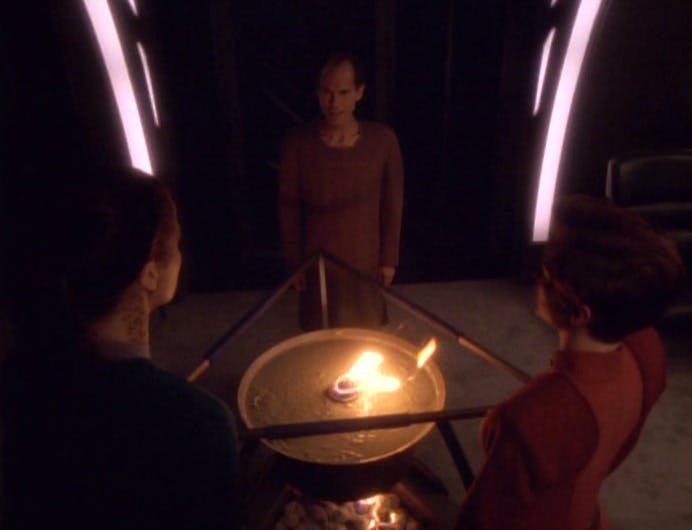
"Facets"
Today, Star Trek: Discovery inherited quite a bit of useful lore from "Facets," and the recent episode, " Jinaal ," even gives us touches of what made "Facets" so compelling to begin with. Here’s why this groundbreaking DS9 episode is so utterly fantastic, and influential to this day.
On the surface, "Facets" is a wacky sci-fi set-up in which Jadzia asks to "borrow" the bodies of her best friends. But instead of a Freaky Friday (or " Spock Amok ") style switcheroo, "Facets" is a deeper story, all about Jadzia meeting her previous hosts, physically , instead of those memories just existing inside of her.
Luckily, this doesn’t require her symbiont to be moved out of her body, because the zhian'tara — a nifty Trill ritual — allows the the personality of one of Dax's previous hosts to be "temporarily removed from the symbiont and imprinted," via telepathy, onto another person. Jadzia Dax chooses the seven people she's closest to on the space station, and then, we, briefly, get to see other Daxes in the bodies of Quark, O’Brien, Bashir, Sisko, Kira, Odo, and Leeta.
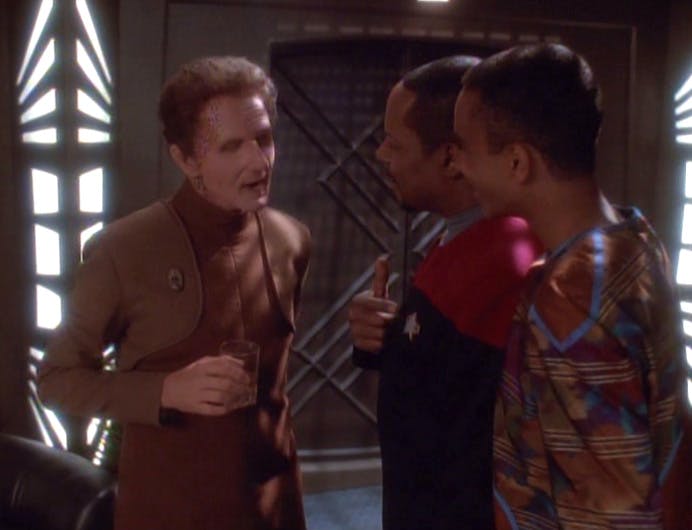
While Odo merging with the personality of Curzon Dax is the most dramatic, and enduring aspect of "Facets," the significance of this episode cannot be overstated not just for the creation of a very profound Trill ability, but because this episode snuck Leeta (Chase Masterson) into the Star Trek family forever.
At the time "Facets" was written, Leeta had only appeared in one episode previously, very briefly in the episode " Explorers ." But, suddenly, in the penultimate episode of Season 3, "Facets" retroactively established that Leeta, someone who worked at the Dabo tables in Quark's bar, was very good friends with Jadzia Dax.
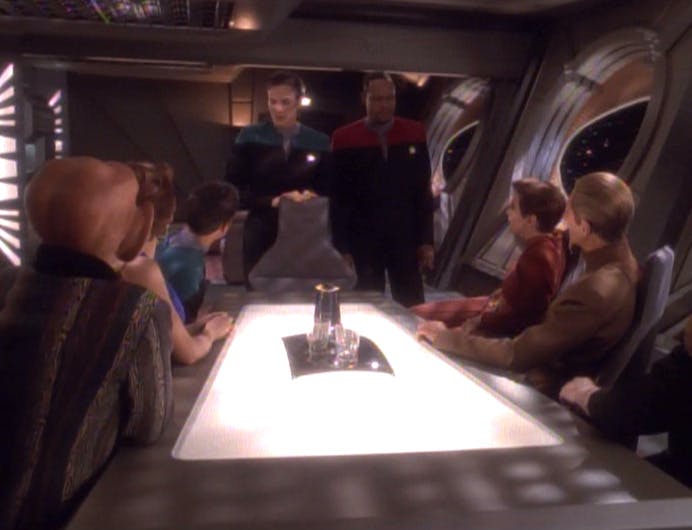
"I thought I was only going to be in one episode," Chase Masterson revealed in 2020, on the DISCO Nights podcast . "It was my second episode! Suddenly, I got a call from wardrobe that I was going to be Emony Dax, and I was like, 'What’s that mean?'"
In the episode, Masterson plays Leeta, of course, but, through the zhian'tara , also plays Emony. In the Trek timeline, Emony was an Olympic gymnast who lived in the 23rd Century, and, as we later learned in " Trials and Tribble-ations " was also cozy with Dr. Leonard "Bones" McCoy. So, thanks to "Facets" and the zhian'tara , not only did we get details about Emony Dax, but also, later, a connection between DS9 and The Original Series . And even though we never saw Leeta and Dax growing closer on-screen prior to this episode, bringing Chase Masteron back as Leeta had a massive impact on Star Trek fandom. "It kinda meant I was in the group," Masterson remembers. "I felt lucky and of course, it changed everything."
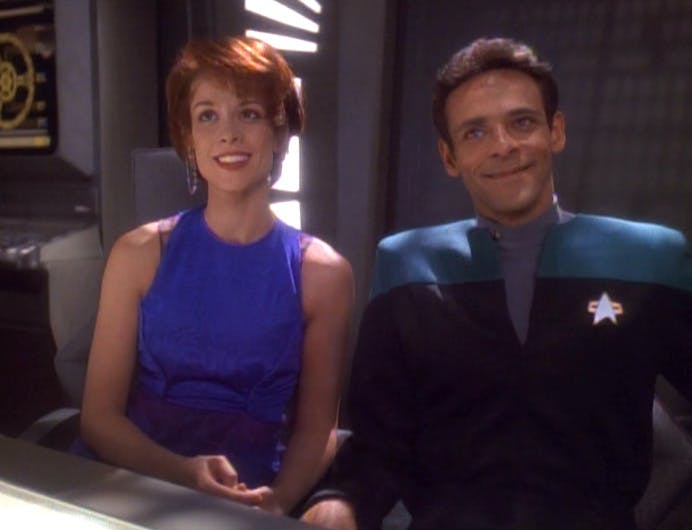
Fans who attend conventions and events like Star Trek: The Cruise are fully aware of just how active and integral Masterson is to modern Trek fandom. As a co-founder of the Pop Culture Hero Coalition , Masterson helped create an anti-bullying program which is the only social emotional learning program used by the YMCA nationwide. Would any of this have happened if Chase Masteron hadn’t been brought into the family in "Facets"? It seems unlikely!
Masteron remembers "Facets" as an "intense episode," and it's that intensity which made it such an important part of Star Trek history. In fact, the emotionally-charged nature of "Facets" is part of what made Discovery ' s recent zhian'tara episode so compelling.

"Jinaal"
When Dr. Culber takes on the memories of the titular “Jinaal," we certainly get shades of Curzon Dax in Odo's body. Jinaal is direct, jovial, and more than a little evasive. Like Curzon inhabiting Odo's body, there's a ticking clock in play, a time limit to how long Jinaal can stay in Culber's body without the effect becoming more permanent.
Both Jinaal and Curzon are also hiding part of their motivations, keeping a past memory to themselves, for fear of what the current members of Starfleet might do with it. In "Facets," Curzon was keeping a very personal memory close to him, the idea he was in love with Jadzia. For Jinaal, he's not too sure Starfleet in the 32nd Century can handle the power of the Progenitor tech.
Somewhat appropriately, and in a sense, with a poetic connection, Jinaal Bix was a Trill working for Starfleet back in the 24th Century during the Dominion War; very close to the same timeframe that Jadzia had her zhian'tara in "Facets."
Did Jinaal Bix know Curzon Dax, or even Jadzia Dax? While we don’t know the exact answer to that question, Discovery ' s recent return to the zhian'tara , and to a storyline that honors Deep Space Nine isn't just fan service. It creates a meaningful connection across generations and centuries, which, appropriately, is exactly what the Trill do, too.
In Star Trek , the Trill teaches us that we're never too old — or too young — to learn something new.
Get Updates By Email
Ryan Britt is the author of the nonfiction books Phasers on Stun! How the Making and Remaking of Star Trek Changed the World (2022), The Spice Must Flow: The Journey of Dune from Cult Novels to Visionary Sci-Fi Movies (2023), and the essay collection Luke Skywalker Can’t Read (2015). He is a longtime contributor to Star Trek.com and his writing regularly appears with Inverse, Den of Geek!, Esquire and elsewhere. He lives in Portland, Maine with his family.
Star Trek: Discovery Seasons 1-4 are streaming exclusively on Paramount+ in the U.S., the UK, Canada, Switzerland, South Korea, Latin America, Germany, France, Italy, Australia and Austria. Seasons 2 and 3 also are available on the Pluto TV “Star Trek” channel in Switzerland, Germany and Austria. The series streams on Super Drama in Japan, TVNZ in New Zealand, and SkyShowtime in Spain, Portugal, Poland, The Nordics, The Netherlands, and Central and Eastern Europe and also airs on Cosmote TV in Greece. The series is distributed by Paramount Global Content Distribution.


COMMENTS
In this, STAR TREK's first pilot, the crew of the Enterprise employ a laser cannon in a deserperate bid to save Captain Pike! Now remastered to 4K/48fps, fr...
A laser cannon was a large laser device used for industrial mining, as a directed energy cannon weapon aboard spacecraft and other installations, or as ground artillery. (TOS: "The Cage"; ENT: "Demons"; TNG: "Conundrum") Starfleet's surface-deployable laser cannons that utilized energy transferred from a starship in orbit illustrate the late maturity of the technology. Showing a clear design ...
Towards the end of Act II, the landing party beamed down the ship's laser cannon and attempted to use it to burn through the elevator door to rescue Captain Pike. Right before the laser cannon fired, Number One, played by Majel Barrett-Roddenberry, grabbed her protective safety goggles and attempted to put them on.
A Starfleet laser cannon (2254) A Starfleet laser pistol, circa 2265. A Solari laser weapon (2365) In The Making of Star Trek, Gene Roddenberry stated that two days into the filming of the second pilot, they realized that three years later people are going to say "Oh, come on, ...
In the pilot episode of Star Trek (the original series), the Talosians abduct Captain Christopher Pike, commander of the starship Enterprise. A rescue missio...
A Starfleet laser cannon in 2254. Hippocrates Noah's laser. A laser was a directed-energy technology utilizing a beam of light, with all wavelengths equal and all particles in phase with one another. Due to this, the photon's motion was almost parallel, which allowed the beam to travel over a great distance with very little increase of the beam's square area, and therefore with little loss of ...
Phasers from "Star Trek VI", with individual markings (The Art of Star Trek) Type-2 phaser around 2364 (Star Trek Fact Files) Type-2 phaser around 2366 ... Laser cannon (Star Trek Fact Files) Isomagnetic disintegrator, oblique view (Star Trek Fact Files) Isomagnetic disintegrator, 3 views (Star Trek Fact Files)
Sci-fi. Star Trek. Laser cannon was an application of laser technology, a type of energy weapon used by Starfleet in the 22nd century and 23rd century. The predecessor to phaser weaponry, the laser weapons used by the Federation Starfleet until the 2260s decade used a microwave laser beam that was fired through a...
Laser gun around 2254. (Star Trek Fact Files) Laser Acronym for L ight A mplification by S timulated E mission of R adiation. Laser weapons have been replaced by the more powerful phasers at latest in the 23rd century. However, lasers are still in use as cutting and welding tools ("The Cage", TNG: "Suddenly Human", "Starship Mine").
A friendly reminder regarding spoilers!At present the expanded Trek universe is in a period of major upheaval with the continuations of Discovery and Prodigy, the advent of new eras in gaming with the Star Trek Adventures RPG, Star Trek: Infinite and Star Trek Online, as well as other post-57th Anniversary publications such as the ongoing IDW Star Trek comic and spin-off Star Trek: Defiant.
Another video of my HMS/Rodd.com Cage Laser with 445nm Blue laser installed.
From Wiki on Star Trek Phaser: Originally (from the production notes to TOS), the Phaser was a PHoton mASER, since at the time of writing the Laser was a relative unknown, and powers were not expected to be very great. Masers, on the other hand, were already very powerful machines which produce very destructive radiation pulses.
The navigational laser beam was a part of the navigational systems on Federation Starfleet Constitution-class starships in the mid-23rd century. In 2266, navigator David Bailey reported interference to the USS Enterprise's navigational laser beam moments before the ship was hit by a cosmic storm. (TOS comic: "Life Form Nonexistent")
Giant laser from 'Star Trek' to be tested in fusion breakthrough. The breakthrough came in an impossibly small slice of time, less than it takes a beam of light to move an inch. In that tiny ...
A laser pistol, or hand laser, was a directed-energy weapon utilized by the Klingon Empire and the United Federation of Planets. (TOS: "The Cage", "A Private Little War") The pistols used by Starfleet in the 2250s and 2260s were designed with multiple power settings. For example, they had enough power to blast through rocks and security glass, and to disintegrate Humanoid-size androids. The ...
Mick's patent pending laser cannons are now available for your ST:TNG game! Being in the business of manufacturing, Mick has painstakingly recreated, improved upon, and redesigned the ST:TNG turrets as replacements for your game. Few will remember that the original prototypes had a red dome on top that was removed from William's to keep the ...
A laser pistol or hand laser was an early type of hand-held Phaser technology commonly used in the early half of the 23rd century. They were a successor of the phase pistol and preceded the Type-2 phaser. Early hand lasers were in use by as early as 2045 on Earth. (TOS novel: Strangers from the Sky) By 2169, laser pistols replaced phase pistols as the main sidearm in Starfleet. Starfleet-issue ...
This text actually describes laser cannons rather than turbolasers, but the colloquial usage of the terms "laser cannon" and "turbolaser cannon" are so intermingled that we cannot be sure that this does in fact refer to a laser rather than a turbolaser. Since turbolasers are more powerful than lasers, the conservative route is to assume that it ...
Star Trek: ENT Silent Enemy 1x12. No Copyright Infringement Intended, All rights go to CBS and Paramount Pictures, this is purely meant for entertainment. Fo...
But the point here is that Star Trek pre-history begins in the 1990s. "Space Seed" established that Khan was a tyrant who ruled part of Earth in the 1990s and was exiled in suspended animation ...
The laser rifle was a hand-held energy weapon, the predecessor of the phaser rifle. It was used on Earth as early as the mid 21st century. (TOS novel: Strangers from the Sky) Laser rifles continued to be in use by Starfleet into the 23rd century, until at least 2266. Captain James T. Kirk used a laser rifle to attack a city builder on the planet Zarta. (TOS comic: "Invasion of the City ...
A phase cannon was a phase-modulated directed energy cannon weapon, a type of particle weapon which served as a successor to plasma cannons and as a precursor to the phaser of the 23rd and 24th centuries. The prototypes of ship-mounted phase cannons were first introduced by Starfleet in the mid-22nd century, designed as the primary defense of NX-class starships and serving as a supplement for ...
As a metaphor for the spectrum of human experiences, the Trill are one of Star Trek's most enduring concepts.But the literal, in-universe workings of the Trill also represent impressive world-building, all of which truly came into its own in Star Trek: Deep Space Nine.Yes, the Trill were invented for the 1990 Star Trek: The Next Generation episode "The Host," but the most intricate and ...
This is a secret weapon that no Starship should be without. That's right, laser guided cannons! And this mod fits the Star Trek pinball theme perfectly. Few...